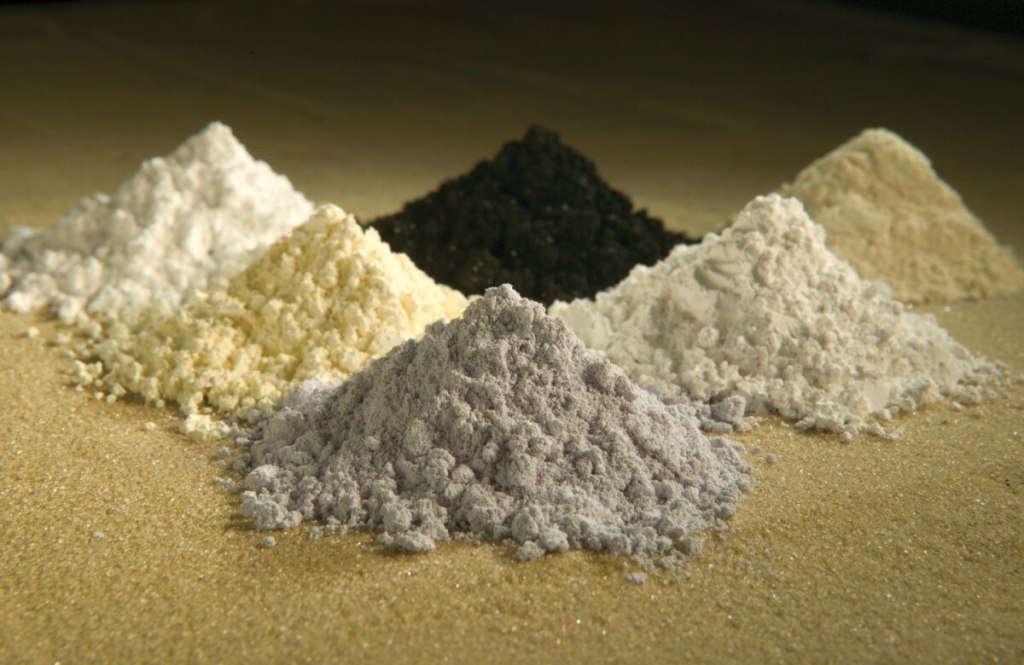By Fayçal Ibrahim.
Rare Earth Elements and their significance
Rare earth elements (REEs) or rare earths are a collection of 17 metallic elements of critical importance in high-tech products, emerging technologies crucial to the transition to sustainable energy, and sophisticated weapons systems. Projections indicate an imminent increase in global demand for rare earths, ranging from 100% to 700% over the coming decades [1]. This underlines their crucial importance and substantial influence on our contemporary world.
Understanding the historical market conditions
Historically, the USA dominated the global supply of rare earth elements, mainly due to the Mountain Pass mine in Nevada [2]. Nevertheless, the current landscape has shifted. China has established a monopoly in the rare earth mining sector, holding a predominant share of over 50% and controlling over 90% of the processing phases [1].
Sources: US Bureau of Mines; US Geological Survey; 2011-2019 data from USGS annual Mineral Commodity Summaries
As an example, we can observe that the United States served as the primary producer and provider of rare earth elements until China assumed dominance in the 1980s, primarily due to Deng Xiaoping’s effective strategy. The reduced US supply resulted from its comparatively higher prices compared to China.
To comprehend China’s dominance in the REE sector, we must look back to the mid-1980s when Deng Xiaoping, the paramount leader of the People’s Republic of China, emphasised the significance of REEs. Recognising their vital role in numerous contemporary products, China strategically prioritised them. The government provided financial incentives and tax breaks to encourage investments in the REE mining and processing sectors. Prudent investments, affordable labor, and lax environmental regulations [3] led to China’s monopoly.
Beijing restored the focus on the rare earth industry in 2015 by incorporating rare earth mining and processing into its “Made in China 2025” strategy [4]. This strategic initiative aimed to transform China from the world’s leading manufacturing center to a top-tier high-tech leader.
Analysing the power relationships within the rare earth elements market
China’s monopoly allowed it to exert influence over REE prices and supply. Notably, China once banned REE exports to Japan amid a diplomatic dispute over Chinese fishers illegally fishing in Japan’s sea, raising concerns that China was wielding REEs as a political tool [5]. The World Trade Organization ruled against the ban, prompting China to implement production quotas and reduce exports, causing a 1000% price increase in some REEs [3].
Moreover, China’s position as the leading global supplier allowed it to threaten the United States of restricting REE exports during the trade war as a response to restrictions on microchip sales to Chinese manufacturer Huawei in 2020.
In January 2022, China announced the creation of a new state-owned enterprise called “China Rare Earth Group”. This company will oversee China’s medium and heavy rare earths, which account for 30-40% of the global rare earths market [1]. The decision reflects the Chinese government’s growing involvement in the industry, which led to Beijing’s recent announcement of export restrictions on two metals widely used in semiconductors and electric vehicle batteries. This decision has heightened tensions in the ongoing trade war with the United States as China is the US’ main supplier, accounting for approximately 74% of imports [6], and will likely lead to further disruptions in the global supply chain. The timing of China’s move, on the eve of US Independence Day and shortly before US Treasury Secretary Janet Yellen’s visit to Li Qiang, Premier of China’s State Council, is widely seen as a provocative gesture by Beijing towards the United States [7].
What lies for the future?
Some fear that China will exploit its influence in the rare earths market to gain an advantage over the USA and its allies in the event of a Taiwan-related conflict. Why? Because many rare earth metals are essential to developing advanced military technologies, including fighter jets, precision laser-guided munitions, satellites, radar systems, and more [5].
Should China decide to invade and annex Taiwan, the government could employ tactics such as blocking all exports to the USA and its allies. This would hamper arms production in these countries, severely limiting their ability to sustain their military efforts throughout the conflict. Western countries’ military arsenals may become unusable if there is a shortage of REEs since components using these metals need replacement every 20 to 30 years.
China could also choose to completely restrict the shipment of metals used in semiconductor manufacturing to the West, including Taiwan. This would pose a further danger to the national security of these countries, as semiconductors are essential to many strategic sectors, such as renewable energies, defense, and advanced technologies. Furthermore, this blockade could potentially mean that Taiwan’s semiconductor industry, one of the best globally and accounting for 15% of the country’s GDP [8], would halt, creating an economic crisis. This would be a tactic of unrestricted warfare, with China seeking to destabilise the country from within, making it weaker to resist invasion.
How are Western countries responding?
The concentration of the rare earth elements market in China worries the West as it increases China’s ability to influence and potentially exploit Western dependence on these metals. Government intervention is therefore essential to support the rapid growth and ramp-up of companies in this sector after decades of neglect by facilitating the adoption of cutting-edge technologies for the processing phase.
In this context, the Pentagon has awarded subsidies of USD 258 million and USD 35 million respectively to Lynas, the primary non-Chinese supplier of light rare earths, and MP Materials, the sole US rare earth miner [9][10]. The goal was to establish heavy rare earth processing facilities within the United States. This enabled Lynas to double its revenue in 2022. It also helped MP Materials to expand their rare earth extraction operations at the Mountain Pass mine in Nevada, allowing them to supply 15% of the world’s total production [11].
Furthermore, in 2020, the Trump administration’s COVID relief package funded 800 million dollars into rare earths research in the US. The European Union also launched a substantial investment program of $12 billion for rare earths and green energy initiatives. In September 2021, the Quad nations (United States, Australia, India, and Japan) reached an agreement to improve global supply chain security for rare earth metals. The goal is to promote their development outside China, including in the European Union and South Korea [12].
Overall, the pandemic exposed the vulnerabilities in the global supply chain, emphasising the shortcomings of relying on consolidated supply, particularly when such monopolies are manipulated for geopolitical and diplomatic advantage. Recent developments, like restrictions on Russian minerals and conflicts in Myanmar, have further disrupted supply chains. In reaction, the United States and its allies are actively pursuing diversification in their sources of rare earths to regain control over this critical sector. Are Western countries taking the right paths to achieve their objective? And how would China respond to these measures? …Only time will tell…
Edited by Justine Peries.
References
[1] Vekasi, Kristin. “Chinese rare earth consolidation a cause for concern.” East Asia Forum, 30 March 2022, https://www.eastasiaforum.org/2022/03/30/chinese-rare-earth-consolidation-a-cause-for-concern/. Accessed 9 November 2023.
[2] Hao, Yufan, and Jane Nakano. “Rare Earth Elements, Asia’s Resource Nationalism, and Sino-Japanese Relations.” National Bureau of Asian Research, 12 May 2011, https://www.nbr.org/publication/rare-earth-elements-asias-resource-nationalism-and-sino-japanese-relations/. Accessed 9 November 2023.
[3] “Tech Companies Depend on China for Rare Earths. Can That Change?” The Wall Street Journal, 04 May 2021, https://www.wsj.com/video/series/in-depth-features/tech-companies-depend-on-china-for-rare-earths-can-that-change/674228C1-D75A-4598-8597-D68108CDA45F. Accessed 9 November 2023.
[4] Why China’s control of rare earths matters. 22 September 2020. Youtube, Financial Times, https://www.youtube.com/watch?v=gyH_PvLZoD0. Accessed 9 November 2023.
[5] Adams, Molly. “Rare Earth Elements: Geopolitical Implications and Challenges for US National Security.” The Geopolitics, 26 May 2021, https://thegeopolitics.com/rare-earth-elements-geopolitical-implications-and-challenges-for-us-national-security/. Accessed 9 November 2023.
[6] Lv, Amy, and Brenda Goh. “Beijing jabs in US-China tech fight with chip material export curbs.” Reuters, 4 July 2023, https://www.reuters.com/technology/us-firm-axt-applying-permits-after-china-restricts-chipmaking-exports-2023-07-04/. Accessed 9 November 2023.
[7] Nguyen, Mai, and Eric Onstad. “China’s rare earths dominance in focus after it limits germanium and gallium exports.” Reuters, 5 July 2023, https://www.reuters.com/markets/commodities/chinas-rare-earths-dominance-focus-after-mineral-export-curbs-2023-07-05/. Accessed 9 November 2023.
[8] “Taiwan’s Semiconductor Industry.” Asian Insiders, 5 September 2023, https://asianinsiders.com/2023/09/05/taiwans-semiconductor-industry/. Accessed 9 November 2023.
[9] Akhand, Himanshi, et al. “Lynas Rare Earths signs updated contract with US government for Texas facility, shares rise.” Reuters, 31 July 2023, https://www.reuters.com/markets/commodities/lynas-rare-earths-signs-updated-contract-with-us-govt-texas-facility-2023-07-31/. Accessed 9 November 2023.
[10] “DoD Awards $35 Million to MP Materials to Build U.S. Heavy Rare Earth Separation Capacity.” Department of Defense, 22 February 2022, https://www.defense.gov/News/Releases/Release/Article/2941793/dod-awards-35-million-to-mp-materials-to-build-us-heavy-rare-earth-separation-c/. Accessed 9 November 2023.
[11] “What We Do.” MP Materials, 2023, https://mpmaterials.com/what-we-do/. Accessed 9 November 2023.
[12] Koty, Alexander Chipman. “The Rare Earths Supply Chain: Why Australia is Getting Serious About Investments.” China Briefing, 29 March 2022, https://www.china-briefing.com/news/the-rare-earths-supply-chain-why-australia-is-getting-serious-about-investments/. Accessed 9 November 2023.
[Cover image] Photo by Peggy Greb, US department of agriculture, licenced under public domain.



Leave a comment